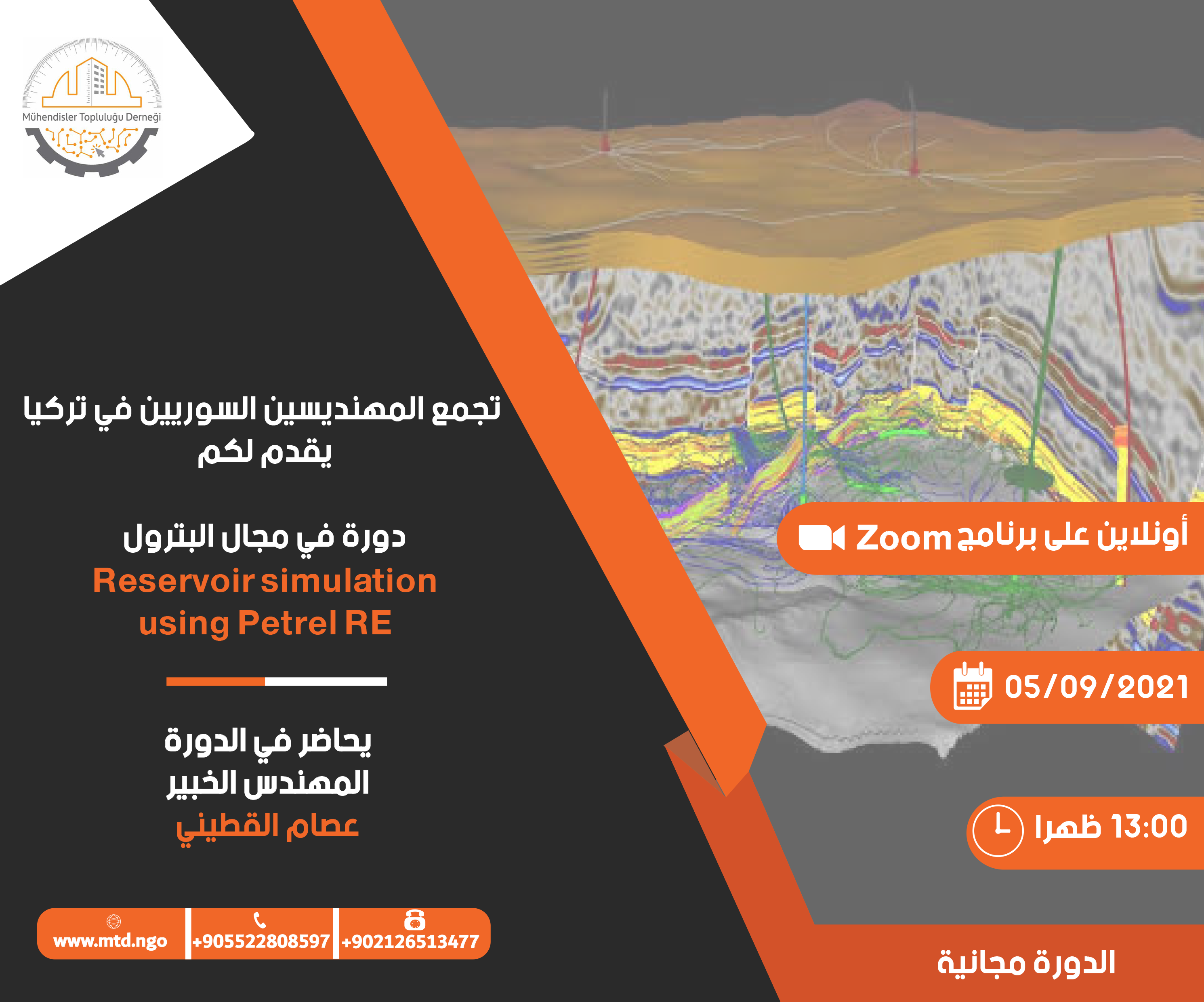تجمع المهندسين السوريين في تركيا
“لجنة البترول”
يقدم لكم:
الدورة النفطية الدولية المجانية الثالثة في هندسة المخزون تحت اسم:
المحاكاة الرقمية للمكامن الهيدروكربونية باستخدام برنامج
Schlumberger Petrel RE
Reservoir simulation using Petrel RE (modelling and software)
يحاضر في الدورة:
المهندس الخبير عصام القطيني
– ماجستير في تكنولوجيا النفط والغاز من جامعة ألبورج في الدانمارك.
– حائز على شهادة إدارة المشاريع من معهد PMI USA
– طالب ماجستير في علم البيانات في ألمانيا.
– خبير في إدارة المكامن الهيدروكربونية العاملة بنظام الإنتاج الذاتي، وحقن المياه والإنتاج الصناعي، وتقدير وتوثيق الاحتياطي من النفط والغاز.
– خبير في مجال الدراسات المكمنية والنمذجة والمحاكاة الرقمية للمكامن.
– مهارات رقمية وتحليلية جيدة وخبرة في العديد من برامج الكمبيوتر المستخدمة في هندسة المخزون.
– عمل لأكثر من عشرين عاماً مع شركات عالمية في الشرق الأوسط وشمال أفريقيا.
الهدف من الدورة:
تحقيق التشابك والفائدة بين المهندسين الخبراء في مجال النفط، والمهندسين الجدد.
الجمهور المستهدف:
– طلاب هندسة البترول والجيولوجيا وحملة البكالوريوس.
– مهندسو وطلاب الماجستير والدكتوراه، ومعاهد النفط والجيولوجيا.
– الخريجون الجدد والخبراء في كل اختصاصات النفط والغاز، ومن كل الجنسيات.
– المهتمون والعاملون في مجال النفط والغاز في الدول العربية، أو المقيمون في الدول الأجنبية.
ميزات الدورة:
مجانية وأونلاين مع خبير دولي
يحصل المشاركون في نهايتها على شهادة حضور بعد اجتياز الاختبارات والاستبيانات، وتحقيق نسبة الحضور المطلوبة.
مكان الدورة:
الدورة أونلاين على برنامج الزوم، والتدريب على برنامج Petrel الشهير من شركة شلمبرجير، والخاص بتخطيط وتنفيذ ونمذجة وبرمجة المكامن الهيدروكربونية والمواضيع المتعلقة بها.
تبدأ الدورة يوم الأحد 5 / 9 / 2021
الساعة 1 ظهراً بتوقيت تركيا بمعدل 6 محاضرات كحد أدنى.
هذا الدورة فرصة نادرة جداً للخريجين الجدد والعاملين في مجال النفط والغاز، والباحثين عن الخبرة ليتعلموا على هذا البرنامج، وبشكل مجاني.
للمشاركة في الدورة يرجى الدخول الى
الملف التعريفي وإتمام عملية الأشتراك:
https://drive.google.com/file/d/1j3yT9k6M1FK6NsNHfR_YeyNdJnpNqwZn/view?usp=drivesdk
مواضيع الدورة:
Reservoir Simulation using Petrel RE
Instructor: Issam Alkutaini
Senior reservoir engineer
Course Objectives & Learning Outcomes
The primary objective of this course is to introduce the audients to Schlumberger Petrel for RE and to cover most of the Petrel simulation workflows. In addition to, presenting the most important relevant concepts and subjects regarding reservoir modelling.
The scope of this course does not include the theoretical background explanations as well as does not include mathematical modeling and simulation; however, the main concepts and ideas will be explored, discussed and manifested, so that a common understanding is guaranteed before and during going through the Petrel demonstration.
The course is intended for students and engineers with little or no modeling experience and aims to arm them with an understanding of the role modelling and simulation can play in solving problems, provide them with keys can open various reservoir simulation doors and to help them, regardless of their major, feel justifiably confident of their ability to build small model that allow them to accomplish useful goals. The class uses the Schlumberger Petrel version 2018.1 software.
At the end of this course and through presenting a step-by-step approach of building simple dynamic model within Petrel environment, audients will have a comprehensive understanding of reservoir model-constructing process as well as they will be able to build a simple dynamic model within Petrel environment. Through this course, you as an audient will be introduced to the main reservoir simulation concepts as well as will learn how to,
– Build a 3D simulation model in Petrel modelling environment.
– Scale up geological model and petrophysical properties.
– Create black oil fluid models and rock physics functions.
– Initialize simulation model.
– Import historical data
– Add wells, and well control rules and create development strategy.
– add aquifer
– Design well (completion engineering will be introduced).
– Setup simulation case, view the results and compare between different cases.
A real simulation case study is demonstrated at the end of the course to help the participants in comprehending the potentials, the benefits and the limitations of reservoir simulation.
مع تحيات تجمع المهندسين السوريين في تركيا


